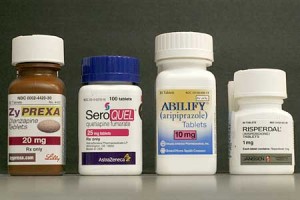 Abilify, Seroquel, Zyprexa, Risperal – these are among the atypical antipsychotics for which Americans paid $10 billion in 2008. $6 billion of that was for off-label use.
Abilify, Seroquel, Zyprexa, Risperal – these are among the atypical antipsychotics for which Americans paid $10 billion in 2008. $6 billion of that was for off-label use.
The FDA only approves drugs when their safety and efficacy have been tested for specific conditions. For example, an antipsychotic might be approved for the treatment of schizophrenia. When it’s prescribed for anxiety or depression, that’s an off-label use.
After heavily marketing off-label use, the makers of Zyprexa, Seroquel, and Abilify were fined a total of $2.3 billion for their defiance of FDA regulations. For the pharmaceutical industry these days, that’s just part of the cost of doing business.
This new generation of atypical antipsychotics is much more expensive than earlier drugs, which are now available as generics. According to a new study, they are not only more expensive. They are neither safer nor more effective than their predecessors, as initially assumed. Here’s what WebMD had to say. (emphasis added)
“Atypical agents were once thought to be safer and possibly more effective,” says study researcher G. Caleb Alexander, MD, an assistant professor in the department of medicine at the University of Chicago Hospitals. “And what we’ve learned over time is that they are not safer, and in the settings where there’s the best scientific evidence, they are no more effective.” …
“Since there were all these new drugs, and it costs 700 to 800 million to bring a drug to market, drug companies needed to make that money back,” says Jeffrey Lieberman, MD, chairman of the department of psychiatry at Columbia University, who was not involved in the study. “These drugs were marketed aggressively.”
The study found that prescriptions for atypical antipsychotics have more than doubled since the mid-1990s, from 6.2 million in 1995 to 14.3 million by 2008. Atypicals are the top-selling category of pharmaceutical drugs. The growth is attributed to off-label use.
Over time, the way doctors prescribed those drugs changed, … with doctors becoming more likely to prescribe these powerful medications for conditions in which they had not been rigorously studied or FDA approved, such as anxiety, depression, attention deficit disorder, and for aggression and agitation in dementia patients. …
In children, the use of the drugs skyrocketed, increasing 800% from 1995 to 2005.
“Time and time again what we see is medications that are prematurely adopted in populations that have little or nothing to gain, and this study is yet another example of how both doctors and patients may overenthusiastically or prematurely adopt medicines beyond the evidence base,” Alexander says.
Can we change the future of medicine?
What does this study tell us about the practice of medicine, the pharmaceutical industry, and the eagerness with which patients medicate themselves, their children, and their elderly parents? That this is the future of medicine.
Could it be any different? What would it take?
Part of the problem comes from off-label use, but it’s difficult to stop pharmaceutical companies from promoting off-label use when the costs of the FDA’s fines are simply included in the pricing of the drugs. Doctors are very busy and rely on drug reps to keep them informed. It’s only natural for doctors to assume initially that a newer class of drugs will be safer and more effective than an older class. If that turns out not to be true, doctors aren’t going to hear about it from their drug reps.
The government could reconsider the appropriateness of direct-to-consumer advertising of prescription drugs. Should pharmaceuticals really be promoted in the same way as any other consumer product? The drug industry would argue that any restrictions on advertising violate free speech rights, just as the tobacco industry argues. The majority of the current Supreme Court would undoubtedly oppose any restrictions on the rights of corporations.
What needs to happen is for “consumers” of health care to take back their health and their lives. We are up against myriad financial interests that benefit from convincing us we’re not healthy enough. Our children may not have schizophrenia, but they might be at risk for it. Therefore we need more medical care and more pharmaceutical drugs.
Resistance to further medicalization will be an uphill struggle, but in the long run worth the effort.
Related posts:
DSM-5: A “wholesale imperial medicalization of normality”
Should grief be labeled and treated as depression?
Medicalization then and now
How the pharmas make us sick
How Big Pharma plans to stay big
We’re all on Prozac now
Resources:
Image: Prescription World
Brenda Goodman, Study: Newer Antipsychotic Drugs Are Overused, WebMD, January 7, 2011
Tracy Staton, Study: Antipsychotic use surged despite evidence, FiercePharma, January 7, 2011


Sorry, comments are closed for this post.